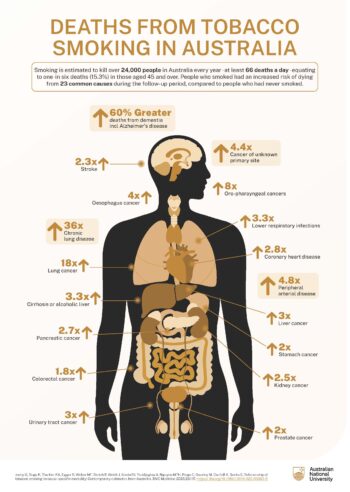
Smoking kills more than 24,000 Australians every year, or 66 people per day, which is significantly more than previous estimates, according to new research using data from the Sax Institute’s 45 and Up Study.
Researchers from the Australian National University followed over 170,000 people from the 45 and Up Study – Australia’s largest ongoing study of health and ageing – for a median of over nine years to provide the most comprehensive evidence to date on smoking and cause of death. They found that smoking increases the risk of dying from 23 common causes.
Compared to people who had never smoked, current smokers had a 36-fold greater chance during follow-up of developing chronic lung disease, an 18-fold greater chance of lung cancer and an eight-fold greater risk of cancers of the mouth, pharynx, larynx, nasal cavity and sinuses.
A three-to five-fold increased risk was found for deaths from lower respiratory infections, peripheral vascular disease and cancers of the oesophagus and liver. The investigators also found increased risk of death from heart disease, stroke, diseases of the respiratory system and a range of other cancers. Death from dementia was 60% more likely in current smokers, compared to people who had never smoked.
“Our findings suggest that the impact of smoking on specific causes of death and the number of attributable deaths has been underestimated,” the study authors write.
They point out that light or moderate smokers in particular often underestimate their still significant risk of dying from their habit. Compared to people who never smoked, those who smoked between just one to 14 cigarettes a day had a 21-fold increased risk of dying from chronic lung disease, a 13-fold increased risk of dying from lung cancer and double the risk of dying from coronary heart disease during the follow-up period.
But the good news was that quitting smoking at any age was beneficial and the increased risks of dying were largely avoided in those who gave up by the age of 45.
“Over the past decade, research using data from the 45 and Up Study has been critical in building up the evidence base for the health impact of tobacco use. It has been included in recommendations by Federal, State and Territory health departments and also used by smoking cessation services,” says Matt Gorringe, Senior Director, Data and Research Services at the Sax Institute.
“With 20 years of data now available from the 45 and Up Study, we’re increasingly seeing how the depth and breadth of our Study data offers unique insights into how behaviours affect people’s health as they age.”
Access the study here.
Find out more about the 45 and Up Study here.






